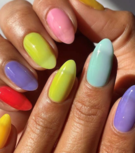STYLE
Beauty
Why sunscreen should be the most important part of your beauty routine this summer
It’s finally time to log off Zoom and get outside. But before you step into the sun, there are a few things you need to know about keeping your skin healthy and protected. Keep reading to learn all the tipcs and tricks to take care of your skin alll summer long—trust us, your skin will thank you.
So what does the sun actually do to your skin?
The two types of UV light you need to know are UVA and UVB rays. UVB actually gives you a sunburn, while UVA is responsible for the damage deep down in your skin that causes darkening and wrinkles.
“These UVA rays tell your cells to produce more melanin to protect your skin from sun damage,” explains dermatologist Shari Marchbein, MD. “So the color you see from a tan or burn is caused by DNA damage.” (In case you missed that: Yes, a tan is just sun damage.)
Over time, it can lead to skin cancer—plus issues like dark spots, wrinkles, decreased elasticity, uneven texture and blotchiness.
When do you actually need to wear sunscreen?
This one is simple: All day, every day—and especially during the hours of 10 a.m. to 4 p.m., when the sun is at its peak.
“A sunburn can happen within minutes of unprotected sun exposure,” says Dr. Marchbein. “Ideally, we’d all wear sunscreen every day of the year, rain or shine, warm or cold.” That includes cloudy days (yep, the sun is still there when you can’t see it!) and even when you’re sitting inside (because the sun can still stream through the window and damage your skin).
How much sunscreen do you actually need to apply?
Sunscreen is only fully effective if you apply enough—and that means you need one full ounce on your body and a teaspoon on your face, says Dr. Marchbein.
“You also need to reapply every two hours and after sweating or swimming,” says dermatologist Annie Chiu, MD. “And don’t forget your neck and the tops of your ears.”
But isn't the sun good for you?
Yes! We all need to spend more time outside, away from our computers, soaking up vitamin D. But know that the only safe tan is a fake one, says Dr. Chiu.
Sun exposure in small amounts (think: 15 minutes) is still the most effective way to absorb vitamin D from the sun’s rays. While wearing sunscreen on the daily is good for maintaining your current levels of the vitamin, you likely won’t increase your stores.
To boost your levels after a long winter, talk to your doctor about spending 15 minutes in the sun between the hours of noon and 3 p.m. before covering up. Then, always follow up with sunscreen and other forms of sun protection, like wide-brimmed hats, sunglasses, rash guards and other clothing that says “UPF” (aka ultraviolet protection factor) on the label.
Aren't some types of sunscreens better than others?
Well...it depends. There are two different kinds of sunscreen: chemical and physical. “Chemical sunscreens protect your skin by absorbing the sun’s rays, while physical [also called mineral] sunscreens reflect the UV light off of your skin,” explains Dr. Marchbein.
Both are effective and come in broad spectrum formulas, meaning they protect against both UVA and UVB light. Physical sunscreens, like Versed Guards Up Daily Mineral Sunscreen Broad Spectrum SPF 35 ($22, Target), are great for sensitive skin. Chemical sunscreens, like Neutrogena CoolDry Sport Sunscreen Lotion with Broad Spectrum SPF 70 ($12, drugstores), hold up better against sweat—ideal if you’re playing sports.
And if you want a sweat-safe physical sunscreen? Try the new Coppertone Sport Mineral collection ($8 and up, drugstores).
Note that experts continue to debate the potentially harmful environmental impacts of both chemical and physical sunscreens—and new research is set to come out later this year. Until we know more, the best SPF is the one that you’ll use on the daily.
Do you still need sunscreen if you are wearing a mask?
You guessed it—yes! While your face mask is great for blocking germs, it barely protects your skin. So don’t skimp on your SPF from the cheekbone down. Not-so-fun fact: The more breathable your mask’s material and lighter the color, the less protection you’ll get.
How am I supposed to wear sunscreen with makeup?
You should apply sunscreen as the last step in your skincare routine, right before makeup. But when it comes time to reapply, who wants to rub lotion on top of their foundation and eyeshadow? (Sounds, um, messy.)
Instead, try this genius reapplication trick: Take a beauty sponge and dip it into your sunscreen before gently bouncing it on your skin. Just be sure you use a full teaspoon of SPF and distribute it evenly. If you want an added layer of protection, try dusting on an SPF powder every two hours. (It’s important to note that powders typically aren’t as effective as other forms of sunscreen, so don’t use them solo.) Try Tarte Tarteguard 30 Mineral Powder Sunscreen SPF 30 ($28).
Why do some sunscreens leave a chalky, white cast on my skin?
No one wants to look ghostly—ever—but many physical sunscreens leave a white or gray tinge on your skin. “This is especially problematic for skin of color because titanium and zinc oxide are harder to rub in,” explains dermatologist Rita Linkner, MD.
Try using a sheer, tinted sunscreen with iron oxide on melanin-rich skin, recommends Dr. Marchbein. (We love Drunk Elephant Umbra Tinte Physical Daily Defense SPF 30, $36.) Chemical sunscreens, like Black Girl Sunscreen Broad Spectrum SPF 30 ($19), are great, too, since they blend right in.
What's the best SPF if you are prone to breakouts?
If you’re naturally acne-prone, any little irritation can leave you with a face full of pimples. “Opt for physical sunscreens with zinc oxide and titanium dioxide since they’re much more gentle,” suggests Dr. Marchbein. Try CoTz Sensitive SPF 40 Broad Spectrum ($25).
How can you heal your skin after a sunburn?
“Applying products with humectants like dimethicone and glycerin, which draw mois- ture into the skin, is a great way to heal skin after a burn,” shares Dr. Linkner. Soothing and hydrating ingredients like aloe and shea butter work well, too. Slather on a lotion like Hawaiian Tropic Silk Hydration Weightless After Sun Lotion ($8, drugstores) every day until the redness is gone.
Hey, girl! Just wanted to let you know that a version of this story originally ran in our June/July 2021 issue. Want more? Read the print mag for free *today* when you click HERE.

 become a contributor
become a contributor













.png)



